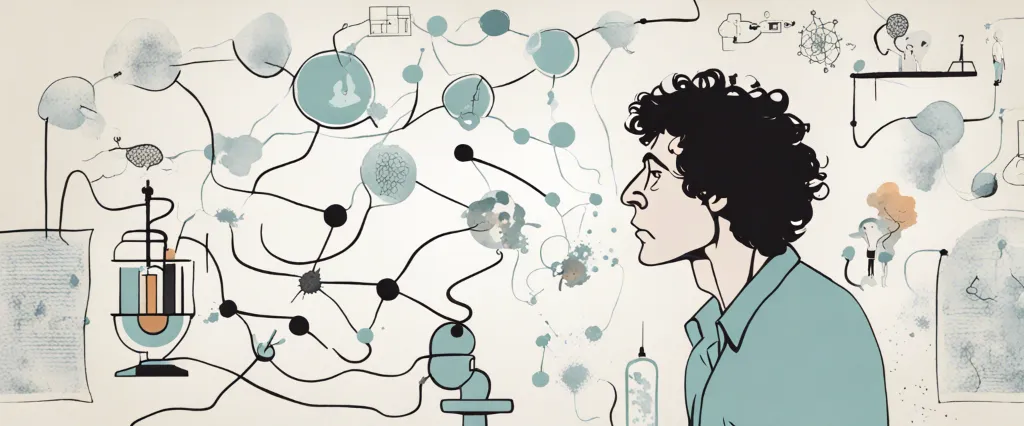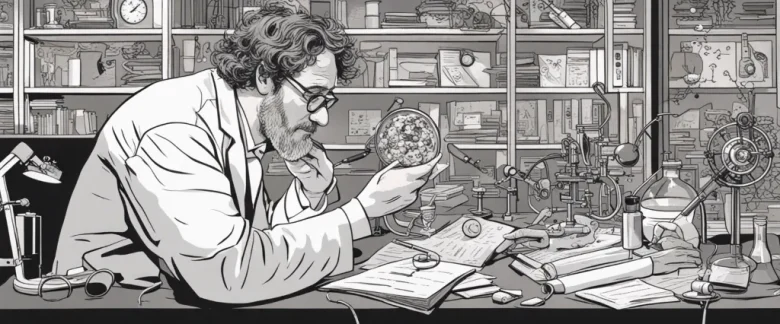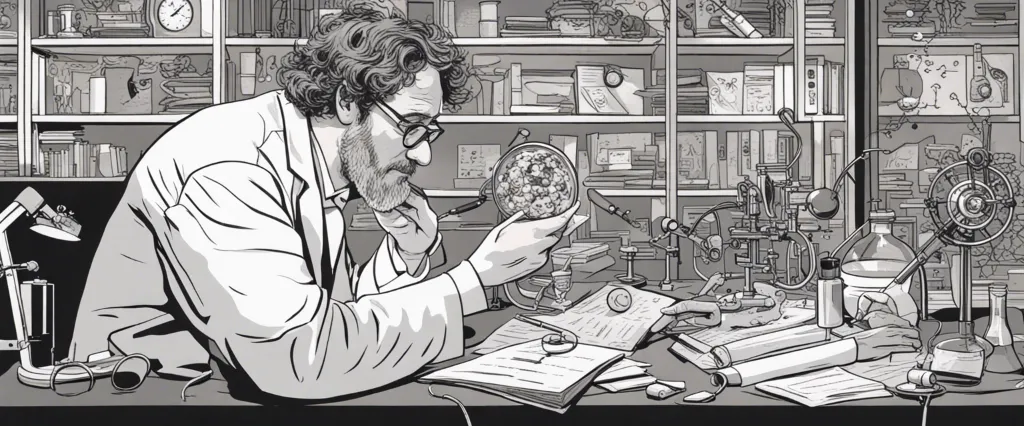In his groundbreaking book “Bad Science,” Ben Goldacre meticulously exposes the numerous flaws and misinterpretations within the realm of scientific reporting. Through his sharp wit and systematic analysis, Goldacre unravels the misleading claims made by media outlets, pharmaceutical companies, and even so-called experts, shedding light on the dangerous consequences of pseudoscience in modern society. As a renowned medical doctor, academic, and science writer, Ben Goldacre combines his expertise in both medicine and journalism to critically dissect scientific inaccuracies, providing readers with the tools to discern reliable information from misleading propaganda. Through his tireless dedication to accurate reporting and transparency, Goldacre empowers readers to navigate the complex world of science with skepticism, ensuring that their decisions are guided by evidence-based reasoning rather than fallacies or manipulation.
Chapter 1: Unmasking Pseudoscience: Exposing the Deceptive World of Bad Science
Chapter 1 of “Bad Science” by Ben Goldacre, titled “Unmasking Pseudoscience: Exposing the Deceptive World of Bad Science,” introduces readers to the world of pseudoscience and the author’s mission to debunk false claims and deceptive practices.
Goldacre starts by discussing the importance of the scientific method, which involves rigorous testing and evidence-based analysis. He highlights the impact of science on public health, technology, and society as a whole. To preserve the integrity of scientific research, he emphasizes the need to expose and challenge pseudoscience.
The author then provides examples of pseudoscience in the media, advertising, and even the healthcare industry. He exposes the manipulative tactics used by companies and individuals to back up their claims with questionable or distorted scientific evidence. Goldacre points out how media often misinterprets scientific findings, and how advertisers cherry-pick favorable studies while disregarding contradictory evidence.
He delves into the world of alternative medicine, discussing homeopathy as a prime example of pseudoscience. Goldacre explains how the principles of homeopathy contradict what is known about chemistry and physics, yet it continues to be promoted and sold to the public as a legitimate form of treatment.
Furthermore, Goldacre examines the role of celebrities in promoting pseudoscience. He discusses their credibility, influence, and how their endorsements can mislead the public into believing unfounded claims. He particularly focuses on detox products, explaining that the body’s natural detoxification systems render such products unnecessary and ineffective.
In this chapter, Goldacre lays the foundation for dissecting the deceptive practices of pseudoscience and highlights the importance of critically evaluating scientific claims. By shining a light on the flaws in the system and exposing misleading practices, he aims to empower readers to make informed decisions based on sound evidence and reasoning.
Chapter 2: The Anatomy of Misinformation: Understanding the Tactics Used to Mislead
Chapter 2 of “Bad Science” by Ben Goldacre, titled “The Anatomy of Misinformation: Understanding the Tactics Used to Mislead,” explores the various techniques employed to deceive people and spread misinformation in the realm of science.
Goldacre begins by highlighting the concept of lay epidemiology, where individuals without proper scientific training make assumptions about causes and effects based on anecdotal evidence. He emphasizes the need for critical thinking and the evaluation of scientific evidence, stressing the importance of statistics, correlation vs. causation, and confounding variables.
The author then delves into the tactics used to mislead people. These include cherry-picking data, which involves selectively choosing information that supports a particular hypothesis while ignoring conflicting data. Goldacre warns against this practice and encourages a comprehensive evaluation of all available evidence.
Another tactic discussed is the “confirmation bias,” which involves interpreting new information in a way that confirms pre-existing beliefs or opinions. This bias can lead to the acceptance of pseudoscience and the dismissal of credible scientific evidence.
Goldacre also explains the concept of the “illusory truth effect,” whereby repetition of false information can convince people it is true. This highlights the importance of fact-checking and scrutinizing sources of information.
Furthermore, the chapter addresses the potential influence of industry on scientific research. Goldacre discusses how pharmaceutical companies often engage in biased reporting, where positive results of clinical trials are published and negative results are overlooked. This practice distorts the scientific evidence base, and the author advocates for transparency and public access to all trial data.
In conclusion, Chapter 2 of “Bad Science” exposes the tactics used to mislead people in the realm of science. It emphasizes the need for critical thinking, evaluation of evidence, and the recognition of potential biases. By understanding these tactics, readers are encouraged to be vigilant and discerning when evaluating scientific claims.
Chapter 3: Flawed Research: Identifying Biases and Methodological Errors
Chapter 3 of “Bad Science” by Ben Goldacre, titled “Flawed Research: Identifying Biases and Methodological Errors,” explores the various ways in which biases and errors can affect scientific research and skew the validity of its findings. Goldacre aims to educate readers about the importance of critically evaluating studies and to equip them with the tools to identify flawed research.
The chapter begins by discussing the concept of bias and the different forms it can take. Goldacre highlights publication bias, where positive results are more likely to be published than negative ones, creating a distorted view of a particular intervention or treatment. He also explores researcher bias, where the personal beliefs or financial interests of the researcher can influence the research process and results.
Goldacre then delves into the issue of methodological errors that can compromise the reliability of studies. He explains how confounding variables and selection bias can lead to erroneous conclusions. Confounding variables are extraneous factors that interfere with the relationship between the independent and dependent variables of a study, potentially distorting the findings. Selection bias refers to when the sample of participants in a study is not representative of the population, leading to biased results.
The chapter also tackles the issue of statistical significance, explaining that small sample sizes and inappropriate statistical tests can lead to false conclusions or inflated claims. Goldacre emphasizes the need for researchers and journalists to understand and accurately interpret statistical data.
In summary, Chapter 3 of “Bad Science” exposes the flaws and biases that can undermine scientific research. By outlining the various ways in which biases and methodological errors can occur, Goldacre urges readers to critically evaluate studies before accepting their findings at face value.
Chapter 4: The Placebo Effect: Separating Fact from Fiction in Medical Treatments

Chapter 4 of “Bad Science” by Ben Goldacre focuses on the placebo effect and its influence on medical treatments. Goldacre begins the chapter by defining the placebo effect as the phenomenon whereby a patient’s symptoms improve purely due to their belief in receiving an effective treatment, even if the treatment itself is inactive or does not have a pharmacological effect.
Goldacre emphasizes the importance of placebo-controlled trials in medicine to distinguish between the actual effects of a treatment and those resulting from the placebo effect. He criticizes alternative medicine practitioners who often rely on testimonials and anecdotes rather than rigorous scientific studies.
The author explores various studies that demonstrate the power of the placebo effect by comparing it to the effects of active treatments. He cites examples where placebos have been shown to provide similar or even superior results to certain drugs or surgeries. Goldacre argues that this highlights the psychological and physiological influences that can be harnessed by placebo treatments.
However, he also highlights the ethical concerns surrounding the use of placebos in clinical practice. While placebos may have a positive effect in some instances, it would be unethical to knowingly provide an inactive treatment to patients when an effective treatment is available.
Goldacre concludes the chapter by calling for transparency in medical trials and acknowledging the role of the placebo effect. He argues that understanding the mechanisms and limitations of the placebo effect is crucial in developing effective medical treatments that minimize its influence and provide genuine benefits to patients.
Chapter 5: Dubious Claims: Debunking False Promises and Miracle Cures
Chapter 5 of “Bad Science” by Ben Goldacre, titled “Dubious Claims: Debunking False Promises and Miracle Cures,” discusses the rampant prevalence of misleading health claims and miracle cures in popular media. Goldacre vehemently criticizes the media, pharmaceutical companies, and alternative medicine practitioners for their role in promoting false promises and exploiting people’s vulnerability.
Goldacre begins the chapter by highlighting the lack of evidence behind many popular health products and treatments. He addresses the phenomenon of “detox” products and reveals that they have no scientific basis and are essentially a marketing scam. Goldacre emphasizes the importance of critical thinking and scrutinizing claims before blindly accepting them.
Furthermore, Goldacre explores the misuse of scientific research by pharmaceutical companies. He draws attention to the selective publication of clinical trial results, where companies often suppress unfavorable findings to market their products more effectively. This leads to biases and misrepresentation, endangering public health and wasting resources on ineffective treatments. Goldacre encourages the publication of all trial data, irrespective of outcomes, to ensure unbiased decision-making.
The author also discusses the ubiquity of alternative medicine and alternative therapists. Despite the lack of scientific evidence supporting their claims, these practitioners often present themselves as credible and trustworthy. Goldacre argues that consumers must be aware of the lack of regulation in alternative medicine and the potential dangers associated with unproven treatments.
In summary, Chapter 5 highlights the prevalence of false health claims and miracle cures, often perpetuated by the media, pharmaceutical companies, and alternative medicine practitioners. Goldacre urges readers to be skeptical, question claims, and demand robust evidence for any purported medical treatment or product. By shedding light on these issues, he aims to empower people to make informed decisions about their own health.
Chapter 6: Misleading Statistics: Unraveling the Tricks of Data Manipulation
Chapter 6 of “Bad Science” by Ben Goldacre focuses on the deceptive use of statistics and how they can be manipulated to mislead and deceive. Goldacre begins by highlighting how important it is to have a basic understanding of statistics in order to critically evaluate scientific claims and avoid being misled.
The chapter delves into different ways in which statistics can be misused. One of the main techniques discussed is cherry-picking data, which involves selectively presenting data that supports a particular narrative while ignoring contradictory evidence. Goldacre gives examples where this has been used to distort the outcomes of medical treatments in order to make them appear more effective than they actually are.
Another method described is the use of relative rather than absolute risk when presenting research findings. Relative risk can make a treatment or intervention look far more impressive than it actually is. By using this tactic, even small benefits can be exaggerated and presented as significant breakthroughs.
The chapter also discusses the problem of publication bias, where positive results are more likely to be published than negative results, leading to a distorted view of a particular treatment or intervention. Goldacre explains how this can be addressed by publishing all results, both positive and negative.
Overall, Chapter 6 of “Bad Science” emphasizes the importance of analyzing statistical data critically and being aware of manipulative techniques that can be used to mislead. By understanding these tricks, readers can develop a more informed perspective on scientific claims and avoid falling victim to data manipulation.
Chapter 7: The Influence of Big Pharma: Examining the Pharmaceutical Industry’s Impact on Science
In Chapter 7 of “Bad Science” by Ben Goldacre, titled “The Influence of Big Pharma: Examining the Pharmaceutical Industry’s Impact on Science,” the author delves into the questionable practices and undue influence exerted by the pharmaceutical industry on scientific research.
Goldacre begins by outlining how pharmaceutical companies fund a significant portion of scientific research, often leading to potential conflicts of interest. He highlights that these financial ties between the industry and scientists may result in biased research outcomes, skewed towards supporting the interests of the pharmaceutical companies.
The author illustrates this influence by discussing the case of Dr. Nancy Olivieri, a hematologist researching a drug called deferiprone. Olivieri raised concerns about the safety and effectiveness of the drug during clinical trials but faced significant pressure from the pharmaceutical company, which threatened to withdraw funding and sue her. This case showcases the power dynamics at play when research conflicts with corporate interests.
Goldacre further explores the pharmaceutical industry’s manipulation of clinical trial data. He exposes the practice of selectively publishing only favorable trial results, while concealing or downplaying negative outcomes. This publication bias distorts the overall evidence base and misinforms doctors, patients, and regulators about the true efficacy and safety of drugs.
Furthermore, the chapter highlights the issue of ghostwriting, where pharmaceutical companies commission medical writers to produce articles that are then presented under the names of reputable academics. This ghostwriting practice allows drug companies to disseminate positive research in a seemingly independent and unbiased manner, deceiving both the scientific community and the public.
Overall, Chapter 7 serves as a critical analysis of how the pharmaceutical industry’s influence can undermine scientific integrity and compromise public health. Goldacre calls for increased transparency, stricter regulations, and a collective commitment to evidence-based medicine to mitigate these issues.

Chapter 8: Fighting for Evidence-Based Medicine: Promoting Critical Thinking and Scientific Rigor
Chapter 8 of “Bad Science” by Ben Goldacre is titled “Fighting for Evidence-Based Medicine: Promoting Critical Thinking and Scientific Rigor.” In this chapter, Goldacre delves into the importance of applying critical thinking and scientific principles in healthcare, and the consequences of failing to do so.
Goldacre begins by highlighting the prevalence of misleading or inaccurate health information in the media, often driven by profit motives, personal biases, or the desire for attention. He emphasizes the responsibility of both journalists and the public to critically evaluate health claims before accepting them as truth.
The author then explores the damaging consequences of the pharmaceutical industry’s inadequate disclosure of trial data. Goldacre exposes how selective publishing and manipulation of results can lead to distorted perceptions of drug efficacy, safety, and side effects. He provides several examples, including the case of selective serotonin reuptake inhibitors (SSRIs) for treating depression.
Goldacre also tackles the issue of publication bias, where positive results are more likely to get published than negative or inconclusive findings, skewing the available evidence. He explains how this bias can occur at various stages, including from researchers, journal editors, and pharmaceutical companies. Moreover, he criticizes the influence of marketing strategies used by pharmaceutical companies that further distort medical research and prescribing practices.
To address these problems, Goldacre champions the importance of evidence-based medicine (EBM), where decisions about patient care are based on empirical evidence from rigorous research. He discusses the role of randomized controlled trials (RCTs) in providing reliable evidence, but emphasizes the need for transparency, sharing of data, and independent scrutiny. He also advocates for changes at the systemic level, including reforms in medical education, the regulation of clinical trial reporting, and better access to trial data.
In summary, Chapter 8 of “Bad Science” presents a comprehensive overview of the challenges faced in promoting evidence-based medicine and the critical thinking required to navigate the complex world of healthcare. Goldacre highlights the dire consequences of biased reporting and data manipulation, while calling for greater transparency, scientific rigor, and reliance on empirical evidence to improve patient care.
After Reading
In conclusion, “Bad Science” by Ben Goldacre exposes the widespread misuse of science within society. The book highlights how certain industries and individuals manipulate research and data to further their own agendas, leading to misleading claims and harmful practices. Goldacre emphasizes the importance of critical thinking, scientific literacy, and the need for transparency in scientific research. By debunking pseudoscience and promoting evidence-based medicine, he calls for a more rigorous approach to science in order to protect the public from misinformation and improve our understanding of the world. Overall, “Bad Science” is a thought-provoking and informative account that empowers readers to question scientific claims and demand better scientific practices.
1. The Demon-Haunted World: Science as a Candle in the Dark” by Carl Sagan
This book delves into the importance of critical thinking and the scientific method in our increasingly complex world. It explores the dangers of pseudoscience and irrational beliefs, providing readers with the necessary tools to separate fact from fiction.
2. “The Skeptic’s Guide to the Universe” by Steven Novella
Written by a team of experts, this book serves as an excellent guide to skeptical thinking. It covers a wide array of topics, including pseudoscience, alternative medicine, and conspiracy theories. With engaging writing and practical advice, it empowers readers to navigate the intricate world of science and misinformation.
3. “Skeptics and True Believers: The Exhilarating Connection Between Science and Religion” by Chet Raymo
This book explores the interplay between science and religion, offering a balanced perspective on the compatibility of the two. Through thought-provoking examples and stories from history, Raymo encourages readers to appreciate the wonders of science while presenting a compelling argument for its harmony with religious thought.
4. “Flim-Flam!: Psychics, ESP, Unicorns, and Other Delusions” by James Randi
With wit and sharp intelligence, James Randi exposes various fraudulent claims and deceptions. This book demonstrates how to spot charlatans and understand the tricks they use to exploit people’s beliefs. It serves as a fascinating exploration of skepticism, debunking paranormal phenomena with entertaining anecdotes and real-life examples.
5. “Science Set Free: 10 Paths to New Discovery” by Rupert Sheldrake
Rupert Sheldrake challenges the prevailing scientific dogmas in this thought-provoking book. Examining the limitations of the scientific establishment, he suggests new areas of research and alternative approaches that could lead to paradigm-shifting discoveries. By encouraging readers to question traditional assumptions, Sheldrake invites them to embrace the spirit of scientific inquiry.




